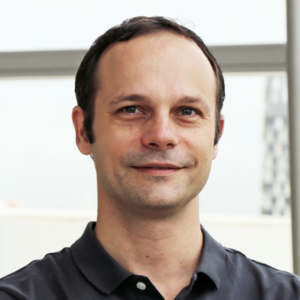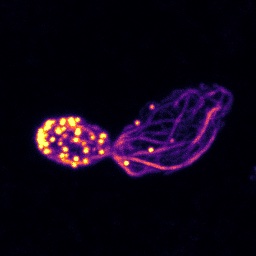
Alphée Tristan MICHELOT
Principal Research Fellow, Mechanobiology Institute, National University of Singapore
alphee@nus.edu.sg
Level 9 T-Lab
National University of Singapore
5A Engineering Drive 1
Singapore 117411
Alphée Tristan Michelot
Principal Investigator
Research Areas
Cytoskeleton organization and dynamics, Bioenergetics
Research Interests

Actin cytoskeleton organization in the yeast S. cerevisiae.
The cellular cytoskeleton is composed of proteins that can polymerize into tubes or filaments. These biological polymers form a dense and organized network that allows cells to resist mechanical constraints or to exert forces through the action of molecular motors or by network reorganization. The cytoskeleton is essential for many cellular functions, including migration and division. Some diseases, in particular certain types of cancer, are associated with defects in the cytoskeleton. Therefore, a fundamental understanding of all the subtleties of its functioning is essential to explain certain pathological behaviors.

“The actin and the balloon”: Actin-based motility assay.
Our goal is to understand the fundamental physical and molecular principles that govern the organization, dynamics, and function of the cytoskeleton in cells. The biological questions that motivate us include: how do cytoskeletal regulatory proteins coordinate to form networks of appropriate architectures and mechanical properties? how do cells maintain rapid cytoskeletal dynamics that allow them to reorganize on sub-minute timescales? What fraction of available energy is consumed by cytoskeletal networks, and how do they reorganize in response to changes in energy levels? How do mutations in these proteins affect the proper functioning of this remarkable machinery?
We are a team of biologists, physicists, and chemists. Our experimental strategy is to address these questions at different levels of complexity using cross-disciplinary approaches. In vitro, we take a reductionist approach based on the idea that any biological process is well understood from the moment we are able to reconstitute it from its most elementary building blocks. In vivo, we use model genetic organisms such as yeast to study these mechanisms at the cellular level.
Education
BS in Physics and Chemistry, Ecole Normale Supérieure de Lyon (ENS), France
MS in Biophysics, Grenoble University, France
PhD in Biophysics and Biochemistry, Grenoble University, France
Biography
Alphée Michelot studied physics and chemistry at the Ecole Normale Supérieure de Lyon (ENS) in France. He first passed competitive exams to teach at high school and bachelor level (“agrégation of Physique-Chimie” in 2003). He then turned his attention to scientific research, obtaining a Master’s degree in Biophysics from the University of Grenoble in 2004 and going on to do his PhD under the supervision of Dr Laurent Blanchoin, developing methods to image the assembly of actin in vitro from single filaments into complex networks. In 2008, he moved to the laboratory of Prof David Drubin’s lab at the University of California, Berkeley, where he established yeast cell extracts as a powerful system for developing new biomimetic systems. After his postdoc, he returned to France and established his group at the Institute of Developmental Biology of Marseille (IBDM) in 2015 with funding from the European Research Consortium (ERC), the Agence Nationale de la Recherche (ANR), the Labex Inform and the Fondation pour la Recherche Médicale (FRM). In 2024, he moved to the Mechanobiology Institute (MBI) at the National University of Singapore, where he holds a joint appointment with CNRS (Centre national de la recherche scientifique, French national Centre for scientific research) as research director and as director of the International Laboratory “Bridging Mechanobiology and Medicine” (IRL3639).
Recent Publications
- Dinet C, Sebban-Kreuzer C, Byrne-Kodjabachian D, Lhospice S, Herrou J, Durbesson F, Vincentelli R, Michelot A, Mignot T. Cell polarity control by an unconventional G-protein complex in bacteria. bioRxiv. (2024)
- Kandiyoth FB, Michelot A. Reconstitution of actin-based cellular processes: why encapsulation changes the rules. Eur J Cell Biol. (2024)
- Toret C, Picco A, Boiero-Sanders M, Michelot A, Kaksonen M. The cellular slime mold Fonticula alba forms a dynamic, multicellular collective while feeding on bacteria. Curr Biol. (2022)
- Boiero Sanders M, Toret CP, Guillotin A, Antkowiak A, Vannier T, Robinson RC, Michelot A. Specialization of actin isoforms derived from the loss of key interactions with regulatory factors. EMBO J. (2022)
- Belbahri R, Michelot A, Heuvingh J, Du Roure O. Non-linear elastic properties of actin patches to partially rescue yeast endocytosis efficiency in the absence of the cross-linker Sac6. Soft Matter. (2022)
- Colombo J, Antkowiak A, Kogan K, Kotila T, Elliott J, Guillotin A, Lappalainen P, Michelot A. A functional family of fluorescent nucleotide analogues to investigate actin dynamics and energetics. Nat Comm. (2021)
- Boiero Sanders M, Antkowiak A, Michelot A. Diversity from similarity: cellular strategies for assigning particular identities to actin filaments and networks. Open Biol. 2020
- Planade J, Belbahri R, Boiero Sanders M, Guillotin A, du Roure O, Michelot A, Heuvingh J. Mechanical stiffness of reconstituted actin patches correlates tightly with endocytosis efficiency. PLoS Biol. 2019
- Antkowiak A, Guillotin A, Boiero Sanders M, Colombo J, Vincentelli R, Michelot A. Sizes of actin networks sharing a common environment are determined by the relative rates of assembly. PLoS Biol. 2019
Lab Members
Kevin Heinrich Kaub
Research Fellow, Michelot Group
P. Shakthi
Research Assistant, Dye & Michelot Groups
Diya NARANG
PhD Student, Class of August 2025, Michelot Group
Liu Haoqiu
Research Fellow, Michelot Group
Shelly Anne Gnapragasan
PhD Student, Class of August 2024, Michelot Group







